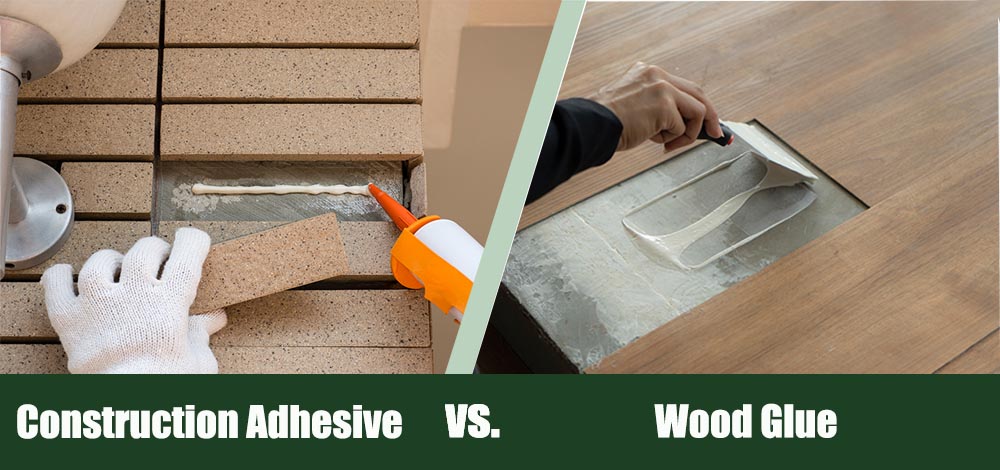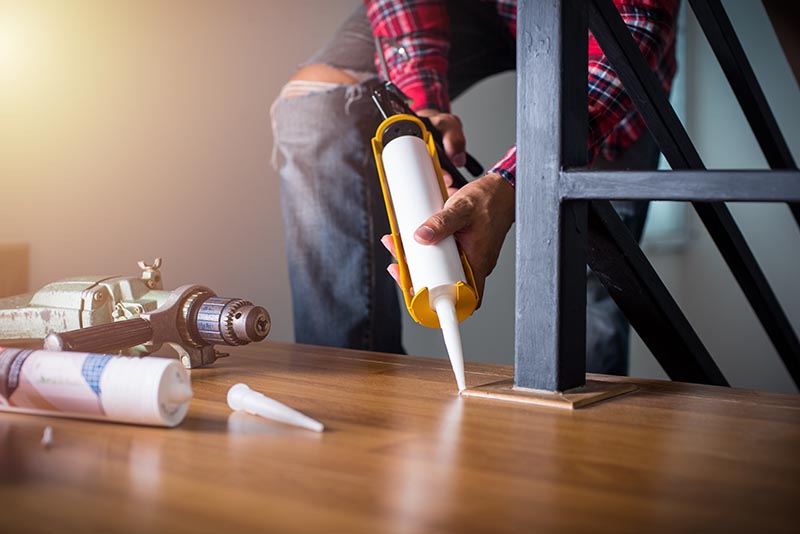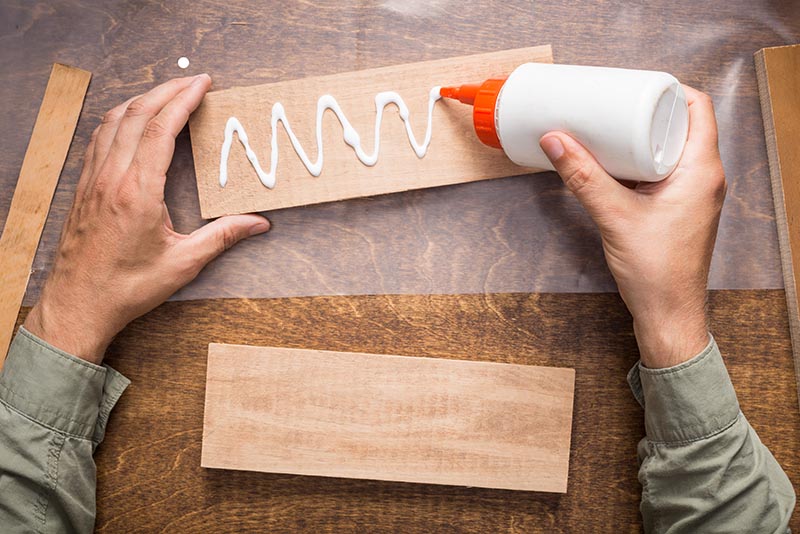Construction Adhesive vs. Wood Glue: Pros, Cons, and Which to Use
-
Codee Chessher
- Last updated:

Whether you are a professional carpenter or an avid DIYer, you want some glue or adhesive on-hand for your projects. Elmer’s School Glue just won’t cut it for large-scale undertakings! But which would be the better choice: construction adhesive or wood glue? While both may seem similar, construction adhesive and wood glue serve different purposes.
Read on to learn the similarities and differences between these two products so that you can decide which one to use.

At A Glance
- Designed for non-porous materials
- High resistivity
- Dries thick
- Good for crafting strong, rigid joints
- Designed for porous materials
- Low resistivity
- Penetrates surfaces and dries thin
- Good for general-purpose woodwork joinery

Overview of Construction Adhesive:
“Construction adhesive” is a catch-all term for adhesives used in the construction industry, with the most common type being epoxy adhesives. This type of adhesive is designed for compatibility, durability, and strength.
When you’re gluing drywall, for instance, you don’t want your results peeling off the wall in a week or two. All types of construction adhesives are designed to defend from impacts, vibrations, and other structural stress common in construction projects.
Construction adhesives are thick and take time to set, ranging from a day to a week or more for the bond to fully cure. Most formulas are much thicker than wood glue, which allows it to fill gaps between surfaces. More importantly, it has a strong grip when filling between surfaces, which ensures a strong bond. Once dry, construction adhesives are more flexible than wood glues, which lets them ‘breathe’ when joints contract or expand without compromising on bond strength.
A notable downside to using construction adhesives is that they’re nearly impossible to remove once applied, making it best for permanent bonding. They’re also significantly more expensive than wood glue because the chemicals involved are more difficult to manufacture.

Types of Construction Adhesives
There are many types of construction adhesives, each with their own carefully crafted formula as well as unique pros and cons. Let’s take a look at some of the most common types of construction adhesives below.
- Acrylic: inexpensive and compatible with a wide range of products, acrylic adhesive forms a strong structural bond on par with rivets
- Epoxy: the most commonly used construction adhesive, epoxies form an extremely tough bond, but two-part formulas can be confusing and messy to work with
- Resin: resinous adhesives offer comparable strength to epoxies, but are easier to apply and don’t resist moisture as well
- Reactive: these adhesives come with the main adhesive compound and a hardener that activates the adhesive, producing extraordinarily strong bonds
When to Choose
Construction adhesives can be used to bond a wide variety of porous and non-porous materials, including wood, stone, drywall, metal, plastic, ceramic, and more. They’re a great all-purpose choice, able to bond disparate materials together with minimal issues.
As the name implies, construction adhesive is suitable for heavy-duty construction projects where durability and longevity are just as important as bonding strength.
You can use construction adhesive instead of wood glue in a pinch, and it’ll probably work well. However, it dries thick, which isn’t suitable for projects intended to appear seamlessly crafted. We’d suggest using it to fill gaps and joints to reinforce pieces bonded with wood glue.
- Produces stronger bonds than wood glue
- Many types available for specialized applications
- Compatible with a wide range of materials
- Can bond disparate materials together
- Dries thick
- Difficult to remove once dry
Overview of Wood Glue:
Wood glue is a type of adhesive used to join wood together. Formulas vary, but all wood glues are designed specifically for woodwork. It’s thinner and runnier than construction adhesive, and dries into a thin, nearly undetectable layer. Because of its lower viscosity and the ingredients used, wood glue dries much faster than construction adhesive, typically within minutes to hours.
Most commercial wood glues use a polyvinyl acetate (PVA) formula, but there are epoxies and polyurethanes available for more heavy-duty applications. The main downside of most wood glues is that they’re usually water-soluble, which makes them simple to clean up, but limits their applications. You don’t want your deck furniture falling apart at the first sign of rain, after all. The good news is that wood glue is very cheap, so you can experiment with what does and doesn’t work for your projects.

Types of Wood Glue
Wood glue has a few major types we touched on above, but let’s learn a bit more about each type and what it has to offer carpenters and woodworkers.
- PVA: appears white but dries clear, PVA is the most prevalent wood glue because it produces a thin, clear, and strong wood bond
- Epoxy: epoxy wood glues create very, very strong waterproof bonds, making it great for projects where durability is important
- Cyanoacrylate: AKA super glue, these glues bond materials quickly but lack the flexibility of other wood glues
- Polyurethane: messier than others, polyurethane wood glue foams when applies and dries thick and strong while also boasting superior flexibility
When to Choose
Wood glue is a go-to for many hobby and crafts projects because it’s cheap and works well with porous materials like paper and cardboard. Its main use is for joining wood together, such as for furniture repair, cabinetry, and small wood crafts. It’s usually used in conjunction with nails, screws, and other mechanical fasteners.
Regular PVA wood glue dissolves with moisture, so you shouldn’t use that if moisture is a concern. Instead, use waterproof epoxy or polyurethane glue. Always check if the glue is waterproof before using it—you don’t want any nasty surprises later.
- Dries thin and clear
- Waterproof options available
- Specifically designed for wood, but works great for both porous and non-porous materials
- Typically cheaper than construction adhesives
- Widely available and affordable
- Flexible bond expands and contracts with wood
- Easy to apply and clean up
- Not as strong as construction adhesive
- The standard PVA wood glue isn’t waterproof
- Not suitable for heavy-duty applications
- Some types may shrink after curing and affect your final results

Conclusion
Both construction adhesive and wood glue are essential tools to bond surfaces together, but they have different uses. Generally speaking, the former offers more heavy-duty strength and permanence, while the latter is best used for wood.
Featured Image Credit: (L) NIKCOA, Shutterstock | (R) appleyayee, Shutterstock
Contents
